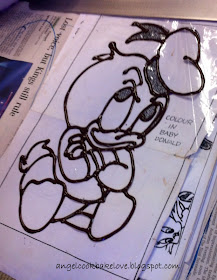31st March 2013
We have one week break last week. This week we are making cutout cake, in this class we concentrate on figure, A-Z or 1-9.
A cutout cake is a 2D cake formed in the shape of a particular character or image. The cake design is similar to, but simpler than, that of a 3D cake. Basically once you learn the principle you can turn just about any image into a cutout cake. They are all free hand cut, so you are not required to buy any special mould.
We were told to bring a square or rectangle cake this time. We also need to think of the figure we want to make and draw on paper. Richard will check our sketch in the class before we cut the cake.
What you need?
- A square or rectangle basic sponge cakes (Richard suggested not smaller than 9”)
- Turntable
- Knife
- Flat spatula
- Whipping cream
- Piping bag
- Food colour
What I learn from this class?
- Principle of cutout cake
- Frosting of cake in irregular shape
- Free hand cut of cake in irregular shape
How to make cutout/figure cake?
- Take a piece of paper, same size as your cake and sketch the figure (in my case I am making “4”). The “body” must be broad; the principle is to minimize cut and wastage. Do not cut out any hole at the centre, we can pipe different colour of cream to represent the “hole”.
- Once you are satisfied with the sketch, cut out the shape.
- Level and slice the cake as usual. Then place the cutout paper on the cake. Cut the cake according to the shape. When cutting straight line just hold the knife as usual (horizontally) but when cutting curve, you need to hold the knife vertically and move the knife in “up down up down” motion to cut the cake.
- Once done, you can start to apply cream and add fillings to each layer. You can also do that before cutting out the shape.
- Crumb coat the whole cake as usual. Then apply another layer of cream (the actual frosting). For the actual frosting unlike round cake which we start to frost from the center, for cutout cake we start from corners. After which, smoothen the top with spatula in one direction. For the sides, technique applied to round cake doesn’t apply here. To get 90 degree angle hold the spatula horizontally and “cut” downwards (like cutting cake). This is not as easy as it sounds! At our level it is difficult to get smooth and nice sides due to the shapes and angles, so Richard suggested us to coat the sides with chocolate rice, almonds flakes etc.
- After frosting the whole cake you can start to decorate the cake.
I only have one 8” and one 11” square tin. 8” is too small so I used the 11’ square tin to bake my cake. Since I was making number “4”, a rectangle cake should be more suitable. So I trimmed my cake into about 9” x 11”.
My cake decoration was very simple. I hided the ugly side frosting by piping little stars all over. I then piped shell around top and bottom borders. I also piped stars at the centre to represent the “hole” in the number “4”. (Note: Green - Wilton tip # 20, Pink - Wilton tip #32). When all the piping was done, I decorated with some ready-made icing flowers and marshmallows (in a way I also used them to cover flaws: P).
For the cake base, I made chiffon cake instead of sponge cake this time. It was matcha chiffon cake with blueberry fillings. First time trying this combination, believe me they are very matching.
I adapted the basic chiffon cake recipe from “Creative Making of Cake” by Chef Alex Goh. I replaced partial flour with matcha powder, replaced water with milk, cut down sugar and liquid in the recipe. The reason I cut down liquid was because I wanted a firmer cake. Nevertheless, the cake was still very soft and moist. Alex Goh’s recipe is always very forgiving.
I am sharing my modified recipe.
Matcha Chiffon Cake
Ingredients:
(A)
8 egg yolk
90g sugar
(B)
100g milk
140g vegetable oil
1/4 tsp salt
(C)
138g plain flour/cake flour
12g matcha powder
2 tsp baking powder
(D)
8 egg white
180g castor sugar
¼ tsp cream of tartar
Method:
- Please refer to HERE.
- The above amount is for my 11”x11” square tin. The egg whites only need to be beaten till soft peak. I only lined the bottom of the pan and did not line or grease the sides.
- If baking in chiffon tin, beat the egg whites till stiff peak. The above amount is good for a 25cm (10”) chiffon tin or you can half the recipe for a 20cm (8”) chiffon tin.
I am submitting this post to
Aspiring Bakers #30: it's Tea time! (April 2013) hosted by Food Playground.






